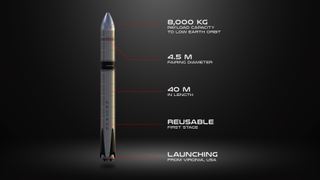Rocket Lab will unveil a 'major development update' on its next-gen Neutron rocket today. Here's how to watch live.
The announcement will begin Thursday, Dec. 2, at 8 a.m. EST (1300 GMT).
Rocket Lab will lift the veil on its next-generation rocket on Thursday (Dec. 2) and you can watch it live online.
The private launch company will unveil a "major development update" on the new rocket, called Neutron, during an online event at 8 a.m. EST (1300 GMT). You'll be able to watch it on this page, courtesy of Rocket Lab, or directly from the company's YouTube page.
Rocket Lab CEO Peter Beck unveiled plans for Neutron, a much larger booster than its current Electron rocket for small satellite missions, in March of this year. Neutron's existence was a surprise announcement for Beck, who long pledged his company would not build a large rocket.
"Earlier this year, I ate my hat," Beck said in a preview video released Nov. 24 for Thursday's announcement. He meant it literally. Beck once said he'd eat his hat if Rocket Lab built a large rocket and he did so (complete with a blender) when he unveiled Neutron in March.
In photos: Rocket Lab and its Electron booster
Now, it seems, Beck is ready to share Rocket Lab's progress on the Neutron rocket. "We've been busy," he said in the Nov. 24 preview.
Neutron is Rocket Lab's entry into the large booster business to serve a growing satellite megaconstellation market and its own ambitions for interplanetary missions to Venus and Mars.
Get the Space.com Newsletter
Breaking space news, the latest updates on rocket launches, skywatching events and more!
As announced in March, Neutron is designed to stand 130 feet (40 meters) tall and launch payloads of up to 8 metric tons (18,000 pounds, or 8,000 kilograms) to low Earth orbit, as well as up to 4,400 pounds (2,000 kg) to the moon. Its first launch is expected to lift off in 2024 from the company's new pad at NASA's Wallops Flight Facility on Wallops Island, Virginia, Rocket Lab has said.

Neutron is also designed to carry just over 3,300 pounds (1,500 kg) to Venus, a target destination for Beck (Rocket Lab wants to launch a small mission to the planet in 2023). The company's Electron, by comparison, is puny: It stands 59 feet tall (18 m) and is designed for tiny satellites weighing up to 660 pounds (300 kg).
It's not clear exactly what Rocket Lab is announcing on Thursday, but it may be a refined design for Neutron, a manufacturing update or a testing schedule.
One thing seems certain: Neutron's first stage will be reusable (an early illustration showed it with landing legs similar to SpaceX's Falcon 9 and Falcon Heavy boosters). Rocket Lab is already pursuing reusability of its Electron first stage, with plans to snatch the booster from mid-air using parachutes and a helicopter. So Neutron may land itself on a landing pad like SpaceX's rockets.
Rocket Lab is also designing Neutron with human spaceflight in mind just in case the company opts to pursue the commercial crewed flight business. The private human spaceflight industry has blossomed in 2021 with the first suborbital space tourism launches by Virgin Galactic and Blue Origin, and the first all-civilian flight by SpaceX, which is already flying astronauts for NASA.
"So, here's the rub: If you're going to build an 8-ton class launch vehicle, and you're going to go to all the trouble to do it, then you may as well make it human-certifiable from day one," Beck told Space.com in a March interview. And he's not ruling out human spaceflight, or anything else for Rocket Lab, ever again.
"I'm never gonna say that I'm never gonna do something again," Beck said at the time. "I'm keeping all options open from this point."
Rocket Lab's Neutron announcement will come as the company is gearing up for its next commercial launch, a mission called "A Data With Destiny." (Rocket Lab is known for its whimsical mission names.)
The "A Data With Destiny" mission will launch two BlackSky Earth observation satellites into orbit from Rocket Lab's Launch Complex 1 (the Virginia site is Launch Complex 2) on the the Mahia Peninsula in New Zealand. The launch window opens on Dec. 7, less than three weeks after Rocket's Lab's Nov. 18 launch of another pair of BlackSky satellites, marking the company's fastest launch turnaround yet.
Editor's note: Visit this page Thursday, Dec. 2, to watch Rocket Lab's Neutron booster update.
Email Tariq Malik at tmalik@space.com or follow him @tariqjmalik. Follow us on Twitter @Spacedotcom, on Facebook and on Instagram.
Join our Space Forums to keep talking space on the latest missions, night sky and more! And if you have a news tip, correction or comment, let us know at: community@space.com.

Tariq is the Editor-in-Chief of Space.com and joined the team in 2001, first as an intern and staff writer, and later as an editor. He covers human spaceflight, exploration and space science, as well as skywatching and entertainment. He became Space.com's Managing Editor in 2009 and Editor-in-Chief in 2019. Before joining Space.com, Tariq was a staff reporter for The Los Angeles Times covering education and city beats in La Habra, Fullerton and Huntington Beach. In October 2022, Tariq received the Harry Kolcum Award for excellence in space reporting from the National Space Club Florida Committee. He is also an Eagle Scout (yes, he has the Space Exploration merit badge) and went to Space Camp four times as a kid and a fifth time as an adult. He has journalism degrees from the University of Southern California and New York University. You can find Tariq at Space.com and as the co-host to the This Week In Space podcast with space historian Rod Pyle on the TWiT network. To see his latest project, you can follow Tariq on Twitter @tariqjmalik.
